-
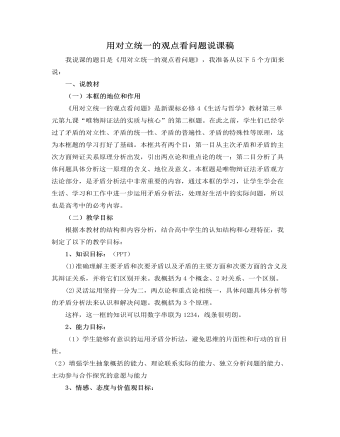
人教版高中政治必修4用对立统一的观点看问题说课稿(二)
【设计意图】通过认识自我这一环节的设计,让学生能够准确的理解矛盾的主次方面,做到能够正确的评价事物,尤其是能够正确的认识评价自己和他人,做到扬长避短,从而达到情感态度价值观目标。为了更好的区分主次矛盾与矛盾的主次方面,在此我以小组赛的形式设计了【我用我学正确识别】这一学生合作探究活动来强化对知识的掌握。(用时大约6分钟)。通过对难点主次矛盾和矛盾主次方面的深入学习,师生共同找出其共同之处:均是两点与重点,从而讲解主次矛盾和矛盾主次方面共同的方法论要求:坚持两点论与重点论的统一。3、坚持具体问题具体分析(约8分钟)由于第二目知识点具体问题具体分析内容上比较简单,因此在过渡后主要以学生自学为主,我围绕“成功”制作两个幻灯片作简单讲解与归纳。

人教版高中政治必修4时代的精神的精华说课稿
(二)能力目标培养学生运用哲学理论观察、分析、处理社会问题的能力,增强学生的时代感。(三)情感、态度与价值观目标培养学生与时俱进的思想品质,让学生关注时代、关注现实、关注生活,逐步树立科学的世界观、人生观、价值观。三、说教学重难点:时代精神的总结和升华是本框的难点,虽然学生在文化生活中学习了文化与经济政治的关系,但要让学生得出哲学是时代精神的总结和升华,还要联系前面关于哲学的基础知识进行总结归纳,因此可能会难以把握,另外关于什么样的哲学是真正的哲学的理解会稍有难度。社会变革的先导是本框的重点,一方面哲学源于时代,另一方面强调哲学反过来对时代又有重要的反作用,突出这一点能够更好地激发学生学习哲学的热情和信心,对于后面知识的学习是极为有益的,因此社会变革的先导这一目作重点处理。
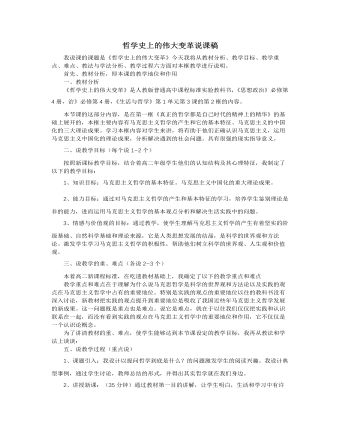
人教版高中政治必修4哲学史上的伟大变革说课稿(一)
2、讲授新课:(35分钟)通过教材第一目的讲解,让学生明白,生活和学习中有许多蕴涵哲学道理的故事,表明哲学并不神秘总结并过渡:生活也离不开哲学,哲学可以是我正确看待自然、人生、和社会的发展,从而指导人们正确的认识和改造世界。整个过程将伴随着多媒体影像资料和生生对话讨论以提高学生的积极性。3、课堂反馈,知识迁移。最后对本科课进行小结,巩固重点难点,将本课的哲学知识迁移到与生活相关的例子,实现对知识的升华以及学生的再次创新;可使学生更深刻地理解重点和难点,为下一框学习做好准备。4、板书设计我采用直观板书的方法,对本课的知识网络在多媒体上进行展示。尽可能的简洁,清晰。使学生对知识框架一目了然,帮助学生构建本课的知识结构。5、布置作业我会留适当的自测题及教学案例让同学们做课后练习和思考,检验学生对本课重点的掌握以及对难点的理解。并及时反馈。对学生在理解中仍有困难的知识点,我会在以后的教学中予以疏导。

人教版高中政治必修4哲学的基本问题说课稿(一)
五.说教学过程:(重点)1.课题引入:课堂探究导入新课。采用教材现成的探究活动导入新课,既“温故”又“知新”,还节约了课堂有效时间。2.讲授新课:(20-25分钟)本课的重难点是关于哲学基本问题的解释,我引用一个很著名的学生也略知一二的唯心主义观点的例子(课堂探究1)顺利进入本课重要知识点的学习,采用案例教学,激发学生的兴趣以及探究问题的欲望,学习哲学基本问题的第一个方面,并用问题和练习形式巩固知识,强化学生易错已混知识点;课堂探究2,同样引用哲学上的著名案例让学生分析探究思考以及合作交流,学生趣味浓厚,主动深入学习本课知识,达到预期教学目的。此时,本课的重点知识教学完成。关于本课的第二个知识点“为什么思维和存在的关系问题是哲学的基本问题”采用学生自主阅读、合作交流的方法,归纳总结,完成本知识目标。3.课堂反馈、知识迁移(10-15分钟)采用学生总结、随堂练习等形式巩固本课知识,同时检验教学效果。可使学生更深刻的理解教学重点。
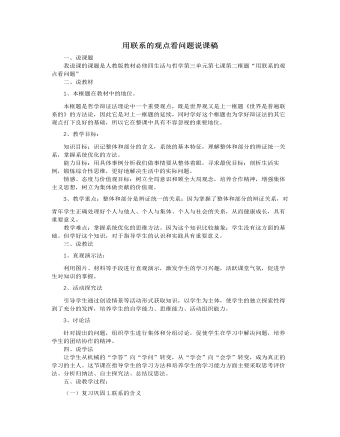
人教版高中政治必修4用联系的观点看问题说课稿
2、系统的基本特征系统观念为人们把握复杂事物提供了一系列科学方法和原则。第一,整体性原则。第二,有序性原则。第三,优化原则。学生的兴趣被激发,可以再调起高潮,让学生听一首歌曲,三个和尚挑水,让学生从愉快的歌声中,明白一个道理:“三个和尚没水喝”,导致这一结果的根本原因就在于人数虽然多了,但没有形成合理的结构,不是相互支持,相互促进,而是相互制肘、相互消磨,结果各要素的力量或作用被内耗了,出现了1+1<2的效应。所以,就要求我们一定要做到:3、掌握系统优化的方法的要求(1)着眼于事物的整体性;遵循系统内部结构的有序性;注重系统内部结构的优化趋向。(2)用综合的思维方式来认识事物巩固练习:以巩固知识为基础,培养能力为目标。
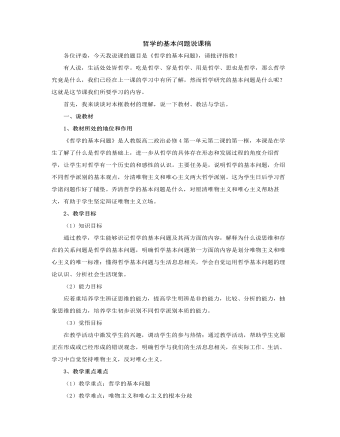
人教版高中政治必修4哲学的基本问题说课稿(二)
②关于哲学的第二个问题是——思维和存在有没有同一性解释同一性——就是说意识(思维)能否正确认识物质(存在)的问题。(让学生表达他们自己的意见)总结得出三种看法——认为意识(思维)可以正确认识物质(存在)的,属于可知论者;凡是认为意识(思维)不能正确认识物质(存在),属于不可知论者。当然也有些同学是两者观点都有,这种同学我们把他称为不彻底的不可知论者。2、为什么思维和存在的关系问题是哲学的基本问题(1)它是人们在生活和实践活动中首先遇到和无法回避的基本问题(举例说明问题,吃饭的时候吃什么菜,学习计划与学习的实际等等)结合教材P10探究进行讲解举例:11月31日请全班同学吃雪糕,吃完后再去肯德基大吃一顿,之后再到卡拉OK唱通宵——不切实际,因为11月并没有31日。(2)它是一切哲学都不能回避、必须回答的问题(不同的回答,直接决定着哲学的不同发展方向。)
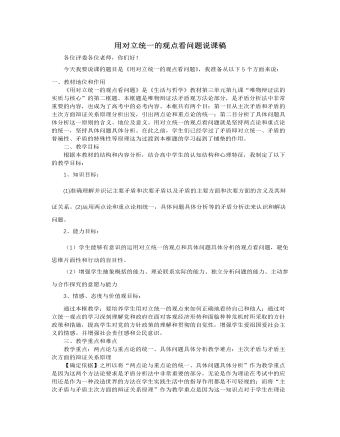
人教版高中政治必修4用对立统一的观点看问题说课稿(一)
1、课题引入:11月16日9时40分许,甘肃庆阳市正宁县榆林子镇发生一起重大交通事故,“校车安全”又一次甚嚣尘上,我设计提问“校车安全事故然表面是偶然,但又是一种必然,你认为事件的原因何在?”的问题激发学生的阅读兴趣。我设计典型事例,通过学生讨论,教师总结的形式,并得出主次矛盾辩证关系的原理分析。2、具体分析事件背后的原因,从原因中发现,这众多的原因矛盾中,都有主次方面之分,由于得出矛盾的主次方面原理。3、从原因中,寻找对策,既坚持重点论与两点论的结合。反对一点论和均衡论。4、无独有偶,在2011年在湖南,海南,广西等地均有类似的事件发生。对比各地事故背后的原因,得出应具体问题具体分析。进而分析具体问题具体分析的意义及地位。
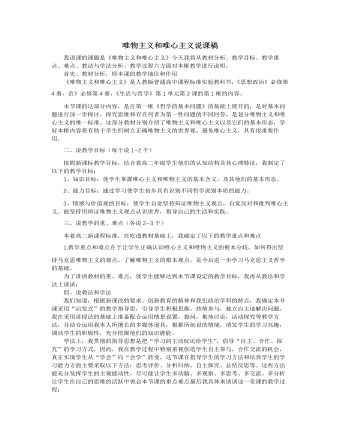
人教版高中政治必修4唯物主义和唯心主义说课稿
五、说教学过程(重点说)1、课题引入:我设计以提问哲学到底是什么?的问题激发学生的阅读兴趣。我设计典型事例,通过学生讨论,教师总结的形式,并得出其实哲学就在我们身边。2、讲授新课:(35分钟)通过教材第一目的讲解,让学生明白,生活和学习中有许多蕴涵哲学道理的故事,表明哲学并不神秘总结并过渡:生活也离不开哲学,哲学可以是我正确看待自然、人生、和社会的发展,从而指导人们正确的认识和改造世界。整个过程将伴随着多媒体影像资料和生生对话讨论以提高学生的积极性。3、课堂反馈,知识迁移。最后对本科课进行小结,巩固重点难点,将本课的哲学知识迁移到与生活相关的例子,实现对知识的升华以及学生的再次创新;可使学生更深刻地理解重点和难点,为下一框学习做好准备。
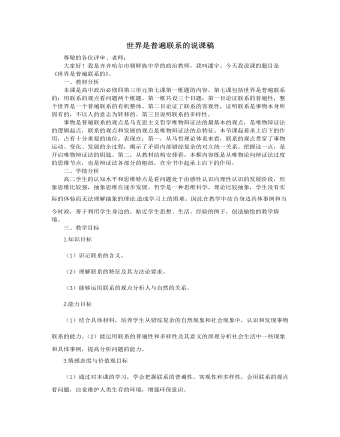
人教版高中政治必修4世界是普遍联系的说课稿
新课程要求学生知识的获得由静态预设到动态生成。作为唯物辩证法的一个总特征、用联系的观点看问题是学生遇到的第一个辩证法思想。本教学设计由日常生活中我们所熟知的情境入手引申到联系的概念、使学生领悟到成语中蕴藏着丰富的哲理。而后通过分析日常生活中的事例一一讲解联系的普遍性、客观性和多样性、体现出生活处处有哲学的理念,符合学生的认知规律。在教学过程中、本教学设计安排了必要的学生活动、锻炼了学生的思维、充分发挥了学生的主体作用。在这一过程中,知识、情感、态度、价值观目标也得到了实现。具体分析如下:第一、这节课利用多媒体教学方式,把书本与丰富多彩的社会生活联系在一起。扩大了学生的眼界和见闻,打破了课堂学习时空的局限,打开了学生思维的心扉,使学生不断产生浓厚的兴趣和探究社会真谛的热情,并真正成为学习的主人,使学生真正成为教学过程的主体。
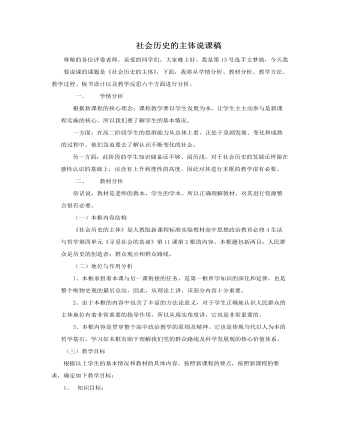
人教版高中政治必修4社会历史的主体说课稿(二)
一、 学情分析根据新课程的核心理念:课程教学要以学生发展为本,让学生主主动参与是新课程实施的核心。所以我们要了解学生的基本情况。一方面:在高二阶段学生的思维能力从总体上看,正处于急剧发展、变化和成熟的过程中,他们急迫要去了解认识不断变化的社会。另一方面:此阶段的学生知识储备还不够、阅历浅,对于社会历史的发展还停留在感性认识的基础上,还没有上升到理性的高度。因此对其进行本框的教学很有必要。二、 教材分析俗话说,教材是老师的教本,学生的学本。所以正确理解教材,对其进行资源整合很有必要。(一)本框内容结构《社会历史的主体》是人教版新课程标准实验教材高中思想政治教育必修4生活与哲学第四单元《寻觅社会的真谛》第11课第2框的内容,本框题包括两目:人民群众是历史的创造者;群众观点和群众路线。
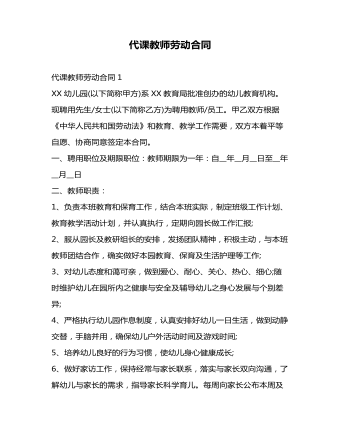
代课教师劳动合同
三、工作报酬、保险与福利待遇第五条甲方根据乙方的工作岗位,按月支付乙方的工资。乙方试用期工资为___元/月,正式聘用期工资由基本工资和绩效工资组成,基本工资为___元/月。绩效工资按甲方依法确定的分配制度、方式和标准执行。如甲方的工资制度发生变化或乙方的工作岗位变动,按新的工资标准确定,并根据乙方的工作岗位,确定每月工资报酬。第六条乙方在甲方处工作满一个学期后可以享受寒暑假的带薪假期。寒暑假只发基本工资___元/月。合同期限届满后甲乙双方不续签合同的,甲方不支付该寒暑假工资。
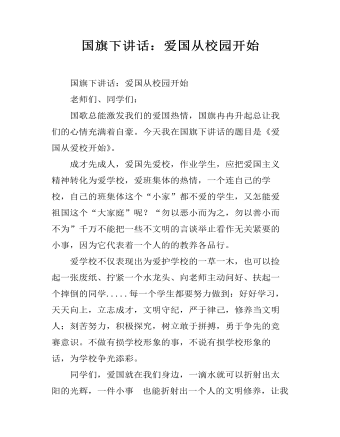
国旗下讲话:爱国从校园开始
老师们、同学们:国歌总能激发我们的爱国热情,国旗冉冉升起总让我们的心情充满着自豪。今天我在国旗下讲话的题目是《爱国从爱校开始》。成才先成人,爱国先爱校,作业学生,应把爱国主义精神转化为爱学校,爱班集体的热情,一个连自己的学校,自己的班集体这个“小家”都不爱的学生,又怎能爱祖国这个“大家庭”呢?“勿以恶小而为之,勿以善小而不为”千万不能把一些不文明的言谈举止看作无关紧要的小事,因为它代表着一个人的的教养各品行。
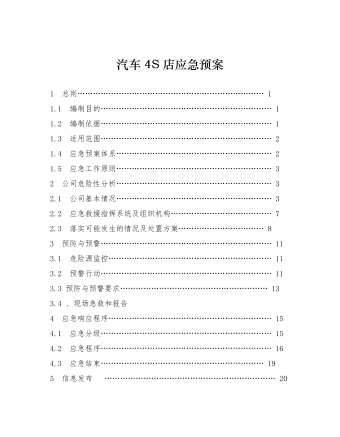
汽车4S店应急预案
( 1 )万一发生火灾及其它事故,立即由安全管理员 *** 同志组织人员排除、救护和疏散现场人员,同时由 *** 同志向 119 、 120 报警,并向到场救援力量报告本公司情况,提供所需资料。( 2 )处置程序①由 *** 同志负责切断火源、电源。②由 *** 同志负责保护和疏散现场人员,同时向市 119 、 120 报警。③由 *** 同志等员工实施抢救。④救援装备:灭火器 6 具,消防沙 1 处,消防铲 5 把,消防水龙头 1 个。2.4 、危险源及风险分析公司的主要危险因素是原料存放处以及生产车间,容易引起火灾和中毒、 触电、机械伤害 。3 、预防与预警

新人教版高中英语必修3Unit 1 Festivals and Celebrations教学设计二
1. Ss look at the picture and scan the passage to understand the main idea while teacher is giving the following questions to inspire Ss to think.*Where are those people?*What are they doing?*Why are they so excited?2. Ss complete the passage with the appropriate -ing form. Then discuss and check the answers with class.Answers: boring, interesting, taking, exciting, amazing3. The teacher raises questions for the students to discuss and encourages them to express their opinions.*Do you like La Tomatina? Why or why not?4. Each group representative reports the discussion result, the teacher gives feedback and the evaluation.Step 6 PracticeActivity 41. Ss complete the Ex 2 in Using structures.2. Check the answers after finishing the exercises.①The dragon boat races are the most exciting part of the Dragon Boat Festival.② The children were excited to go Easter egg hunting.③What an amazing performance! This is the best music festival I have ever been to.④We were amazed by her funny-looking hat.⑤His inspiring speech at the conference won the admiration/ favour of the audience.⑥This is a challenging game to test your memory and observation capabilities. 3. T asks Ss to finish Ex 3 and 4 in Using structures by themselves, then check the answers with class.Step 6 Homework1. Understand and master the functions and usage of the -ing form;2. Finish the other exercises in Using structures.1、通过本节内容学习,学生是否理解和掌握动词-ing形式作定语和表语的功能和意义;2、通过本节内容学习,学生能否在理解文段内容的基础上,根据上下文语境和表达逻辑,能正确运用动词-ing形式描述节日庆典。3、通过本节内容学习,学生是否归纳和积累用于表达情绪的相关词汇。

新人教版高中英语必修3Unit 1 Festivals and Celebrations教学设计一
本板块的活动主题是“谈论节日活动”(Talk about festival activities),主要是从贴近学生日常生活的角度来切入“节日”主题。学生会听到发生在三个国家不同节日场景下的简短对话,对话中的人们正在参与或将要亲历不同的庆祝活动。随着全球化的进程加速,国际交流日益频繁,无论是国人走出国门还是外国友人访问中国,都已成为司空见惯的事情。因此,该板块所选取的三个典型节日场景都是属于跨文化交际语境,不仅每组对话中的人物来自不同的文化背景,对话者的身份和关系也不尽相同。1. Master the new words related to holiday: the lantern, Carnival, costume, dress(sb)up, march, congratulation, congratulate, riddle, ceremony, samba, make - up, after all. 2. To understand the origin of major world festivals and the activities held to celebrate them and the significance of these activities;3. Improve listening comprehension and oral expression of the topic by listening and talking about traditional festivals around the world;4. Improve my understanding of the topic by watching pictures and videos about different traditional festivals around the world;5. Review the common assimilation phenomenon in English phonetics, can distinguish the assimilated phonemes in the natural language flow, and consciously use the assimilation skill in oral expression. Importance:1. Guide students to pay attention to the attitude of the speaker in the process of listening, and identify the relationship between the characters;2. Inspire students to use topic words to describe the festival activities based on their background knowledge. Difficulties:In the process of listening to the correct understanding of the speaker's attitude, accurately identify the relationship between the characters.

新人教版高中英语必修3Unit 2 Morals and Virtues教学设计二
Activity 41. Students complete the task of activity 4, then teachers and students check the answers. 2. The teacher organized the students to work together and asked them to use the tables and mind maps sorted out before to retold the important choices in Lin Qiaozhi's life and their resultsStep 5 Language points1. The teacher asks the students to read the text carefully, find out the core words and long and difficult sentences in the text and draw lines, understand the use of vocabulary, and analyze the structure of long and difficult sentences. 2. The teacher explains and summarizes the usage of core vocabulary and asks the students to take notes. 3. The teacher analyzes and explains the long and difficult sentences that the students don't understand, so that the students can understand them better. Step 6 Homework1. Read the text again, in-depth understanding of the text; 2. Master the use of core vocabulary and understand the long and difficult sentences. 3. Complete relevant exercises in the guide plan. 1、通过本节内容学习,学生是否理解和掌握阅读文本中的新词汇的意义与用法;2、通过本节内容学习,学生能否结合文本特点总结林巧稚的人生原则和人格品质特征;3、通过本节内容学习,学生能否针对人生抉择发表自己的看法;能否全面地、客观地、理性地看待问题,进而对道德和人性有更加深入的思考和理解。

新人教版高中英语必修3Unit 1 Festivals and Celebrations教学设计三
*wide range of origins(= a great number of different origins, many kinds of origins)*It featured a parade and a great feast with music, dancing, and sports. (=A parade and a great feast with music, dancing, and sports were included as important parts of the Egyptian harvest festival.)*.. some traditions may fade away and others may be established.(= Some traditions may disappear gradually, while other new traditions may come into being.)Step 6 Practice(1) Listen and follow the tape.The teacher may remind the students to pay attention to the meaning and usage of the black words in the context, so as to prepare for the completion of the blanks in activity 5 and vocabulary exercises in the exercise book.(2) Students complete the text of activity 5 by themselves.The teacher needs to remind the students to fill in the blanks with the correct form of the vocabulary they have learned in the text.Students exchange their answers with their partners, and then teachers and students check their answers.(3)Finish the Ex in Activity 5 of students’ book.Step 7 Homework1. Read the text again, in-depth understanding of the text;2. Discuss the origin of festivals, the historical changes of related customs, the influence of commercial society on festivals and the connotation and essential meaning of festivals.3. Complete relevant exercises in the guide plan.1、通过本节内容学习,学生是否理解和掌握阅读文本中的新词汇的意义与用法;2、通过本节内容学习,学生能否结合文本特点快速而准确地找到主题句;3、通过本节内容学习,学生能否理清论说文的语篇结构和文本逻辑,了解节日风俗发展与变迁,感悟节日的内涵与意义。

新人教版高中英语必修3Unit 2 Morals and Virtues教学设计三
The joke set her crying.这个玩笑使她哭起来。Step 5 ReadingActivity 31. Students read the small text in activity 3. The teacher provides several small questions to check whether students understand the content of the text and the ideographic function of the -ing form in the text.*Where are those people?*Why did Dr Bethune come to China?*How did he help the Chinese people during the war?*What did Chairman Mao Zedong say about him?2. Ss try to rewrite some sentences using the -ing form. Then check the answers. When checking the answers, the teacher can ask different students to read the rewritten sentences and give comments.Answers:1. he became very interested in medicine, deciding to become a doctor.2. …after hearing that many people were dying in the war.3. Helping to organise hospitals, he taught doctors and nurses, and showed people how to give first aid./ He helped to organise hospitals, teaching doctors and nurses, and showing people how to give first aid.4. …praising Dr Bethune as a hero to be remembered in China.Step 6 PracticeActivity 4Students complete grammar activities 2 and 3 on page 69 of the workbook.Step 6 Homework1. Understand and master the functions and usage of the -ing form;2. Finish the other exercises in Using structures.1、通过本节内容学习,学生是否理解和掌握动词-ing形式作宾语补足语语和状语语的功能和意义;2、通过本节内容学习,学生能否正确使用动词-ing形式描述人物的行为、动作及其经历;3、通过本节内容学习,学生能否独立完成练习册和导学案中的相关练习。

新人教版高中英语必修3Unit 2 Morals and Virtues教学设计四
3.Teachers ask different groups to report the answers to the questions and ask them to try different sentence patterns.The teacher added some sentence patterns for students to refer to when writing.Step 4 Writing taskActivity 51.Write the first draft.Students first review the evaluation criteria in activity 5, and then independently complete the draft according to the outline of activity 4, the answers to the questions listed in the group discussion and report, and the reference sentence pattern.2.Change partners.The teacher guides the students to evaluate their partner's composition according to the checklist of activity 5 and proposes Suggestions for modification.3.Finalize the draft.Based on the peer evaluation, students revise their own compositions and determine the final draft.Finally, through group recommendation, the teacher selects excellent compositions for projection display or reading aloud in class, and gives comments and Suggestions.Step 5 Showing writingActivity 5T call some Ss to share their writing.Step 6 Homework1. Read the passage in this section to better understand the passage.2. Carefully understand the hierarchical structure of the article, and deeply understand the plot of the story according to the causes, process and results;3. Independently complete the relevant exercises in the guide plan.1、通过本节内容学习,学生是否理解和掌握阅读文本中的新词汇的意义与用法;2、通过本节内容学习,学生能否通过人物言行的对比分析道德故事的深层内涵;3、通过本节内容学习,学生能否根据故事的起因、经过和结果来深入理解故事的情节,从而了解文章的层次结构;4、结合现实生活案例发表自己的见解和看法,写一篇观点明确、层次分明的故事评论。

新人教版高中英语必修3Unit 2 Morals and virtues教学设计一
(2) students are divided into groups according to the requirements of activity 3. Each student shares a story of personal experience or hearing-witnessing kindness, and then selects the most touching story in the group and shares it with the whole class. Before the students share the story, the teacher can instruct them to use the words and sentence patterns in the box to express. For example, the words in the box can be classified:Time order: first of all, then, after that, later, finally logical relationship :so, however, although, butTeachers can also appropriately add some transitional language to enrich students' expression:Afterwards, afterwards, at last, in the end, eventuallySpatial order: next to, far from, on the left, in front ofOtherwise, nevertheless, as a result, therefore, furthermore, in addition, as well asSummary: in a word, in short, on the whole, to sum up, in briefStep 8 Homework1. Understand the definition of "moral dilemma" and establish a correct moral view;2. Accumulate vocabulary about attitudes and emotions in listening texts and use them to express your own views;3. Complete relevant exercises in the guide plan.1、通过本节内容学习,学生能否理解理解“道德困境”的定义;2、通过本节内容学习,学生能否通过说话人所表达的内容、说话的语气、语调等来判断其态度和情绪;3、通过本节内容学习,学生能否针对具体的道德困境发表自己的看法和见解,能否掌握听力理训练中的听力策略。